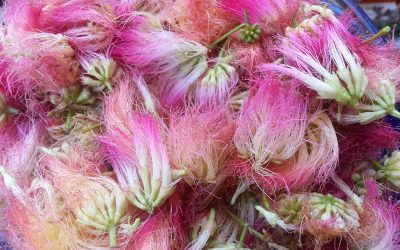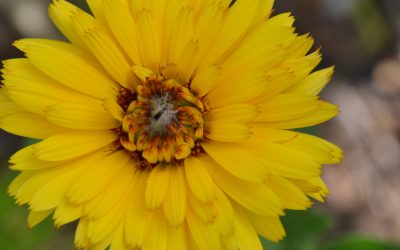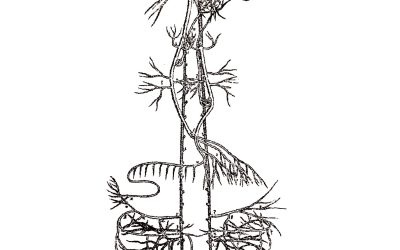For the Love of Weeds: Wild Lettuce and Company
by Dara Saville
A weed by almost any account…
 What do we mean when we call a plant a ‘weed’? Usually that indicates a plant that is growing where we don’t want it to be, a plant that spreads prolifically, or a plant that competes with others we regard to be of higher value. This Horehound (Marrubium vulgare, see photo) certainly is growing with great abundance, having spread throughout my garden on its own accord. It also grows out of the cracks in the concrete walkway leading to the shed in the hinter-lands of my yard. I’ll admit that it also crowds out some plants with more demure personalities. But what about the connotation of the word ‘weed’? Usually it is negative and that is where some of us beg to differ. Weeds, as a group, are my favorite plants. They offer nutrition, medicine, food and habitat for pollinators and other wildlife, and they hold down the fragile desert topsoil after disturbance. I love their tenacity, persistence, and their willingness to stand by our side, regardless of how destructive we may be to the natural cycles of things. I feel that they accept us as we are and offer so much, so freely. Horehound for example, is a pure beauty. Not in the traditional sense, of course. Its got tiny, barely noticeable flowers and produces annoying burrs that get stuck in everyone’s clothes and hair. But that wild form and that penetrating aroma! One whiff and I am taken back to times and places of healing and recovery. Bitterness, expectoration, and the bees simply love her.
What do we mean when we call a plant a ‘weed’? Usually that indicates a plant that is growing where we don’t want it to be, a plant that spreads prolifically, or a plant that competes with others we regard to be of higher value. This Horehound (Marrubium vulgare, see photo) certainly is growing with great abundance, having spread throughout my garden on its own accord. It also grows out of the cracks in the concrete walkway leading to the shed in the hinter-lands of my yard. I’ll admit that it also crowds out some plants with more demure personalities. But what about the connotation of the word ‘weed’? Usually it is negative and that is where some of us beg to differ. Weeds, as a group, are my favorite plants. They offer nutrition, medicine, food and habitat for pollinators and other wildlife, and they hold down the fragile desert topsoil after disturbance. I love their tenacity, persistence, and their willingness to stand by our side, regardless of how destructive we may be to the natural cycles of things. I feel that they accept us as we are and offer so much, so freely. Horehound for example, is a pure beauty. Not in the traditional sense, of course. Its got tiny, barely noticeable flowers and produces annoying burrs that get stuck in everyone’s clothes and hair. But that wild form and that penetrating aroma! One whiff and I am taken back to times and places of healing and recovery. Bitterness, expectoration, and the bees simply love her.
Weeds are inevitable in our lives so why not make the most of it? Just like our digestive  systems, which are colonized by microbes, so too will our gardens and urban areas become prime habitat for opportunistic plants. As with our own bodies, we want those to be helpful or useful organisms and lucky for us most common weeds are actually very valuable plants. Many of those pesky weedy plants growing in your yard and garden make tasty and nutritious foods and they make great medicine, too. As foods, many weedy greens, flowers, and seeds add an array of wild-spirited phyto-nutrients to your diet. Wild Lettuce (Lactuca serriola) and Wild Spinach (Chenopodium) are two of the most abundant wild vegetables that make up my spring and summer diet. Harvesting invasive mustards such as London Rocket (Sisymbrium irio) and Wild Arugula flowers (see photo) are another way to add easy wild beauty to your meals while incorporating a little punch of mustard flavor. Likewise, Siberian Elm (Ulmus pumila) and Common Mallow (Malva neglecta, see photo) provide a seemingly endless supply of tasty green seeds plentiful for the picking during early spring and mid-summer. I particularly enjoy using weeds in my food and medicine because of their wonderfully tenacious and persistent nature and their ability to adapt to wide-ranging
systems, which are colonized by microbes, so too will our gardens and urban areas become prime habitat for opportunistic plants. As with our own bodies, we want those to be helpful or useful organisms and lucky for us most common weeds are actually very valuable plants. Many of those pesky weedy plants growing in your yard and garden make tasty and nutritious foods and they make great medicine, too. As foods, many weedy greens, flowers, and seeds add an array of wild-spirited phyto-nutrients to your diet. Wild Lettuce (Lactuca serriola) and Wild Spinach (Chenopodium) are two of the most abundant wild vegetables that make up my spring and summer diet. Harvesting invasive mustards such as London Rocket (Sisymbrium irio) and Wild Arugula flowers (see photo) are another way to add easy wild beauty to your meals while incorporating a little punch of mustard flavor. Likewise, Siberian Elm (Ulmus pumila) and Common Mallow (Malva neglecta, see photo) provide a seemingly endless supply of tasty green seeds plentiful for the picking during early spring and mid-summer. I particularly enjoy using weeds in my food and medicine because of their wonderfully tenacious and persistent nature and their ability to adapt to wide-ranging conditions, thriving in even the most inhospitable of environments. Weeds are unique and intriguing in their paradoxical way of being in the natural world. They are stubborn in their resilience, yet yielding in their willingness to be harvested and included in any herbal arts. I like imbuing my meals and formulas with this sort of life force and plant personality because we all need a little more durability and adaptability at times. If there were ever herbs to help us meet success against the odds, we will find that medicine in ordinary weeds.
conditions, thriving in even the most inhospitable of environments. Weeds are unique and intriguing in their paradoxical way of being in the natural world. They are stubborn in their resilience, yet yielding in their willingness to be harvested and included in any herbal arts. I like imbuing my meals and formulas with this sort of life force and plant personality because we all need a little more durability and adaptability at times. If there were ever herbs to help us meet success against the odds, we will find that medicine in ordinary weeds.
Many of our most common medicinal weeds are so adaptable and successful that they are seen ubiquitously across much of the country. Dandelion (Taraxacum officinale), Plantain (Plantago major), and Clovers (Trifolium spp.) are all plants that are widely familiar and help to create shared experiences and herbal practices for people across the continent. However, what plants are considered to be weeds varies depending on where you  live. For example, Burdock (Arctium minus), St. John’s Wort (Hypericum perforatum), Mullein (Verbascum thapsus), Self Heal (Prunella vulgaris), Nettles (Urtica dioica), and Dock (Rumex crispus) are all useful herbs that are considered to be weeds in some regions. Local medicinal weeds most commonly seen in my area include Dandelion, Sunflower (Helianthus annuus), Plantain, Redstem Filaree (Erodium cicutarium, see photo), Shepherd’s Purse (Capsella bursa-pastoris), Sweet Clover (Melilotus spp.), Common Mallow (Malva neglecta), Siberian Elm, and Wild Lettuce among others. Collecting a basket full of these weedy herbs will provide you a wide variety of medicinal effects including nutritives, diuretics, choleretics, astringents, demulcents, emollients, styptics, lymph and blood movers, stomachics, immune modulators, anti-spasmodics, and more. These persistent plants can be made into tinctures, salves, creams, sprays, tea, food, liniment, poultices, soaks, and anything else you can dream up. Working with weeds, we integrate ourselves more deeply with our immediate surroundings, we create a more sustainable and cost-effective practice, and we can produce formulas for health and well-being while alleviating the pressure on less common medicinal plants. In a world of changing plant communities and growing human populations, I am always grateful for those plants that are willing to grow alongside us in the perpetual and dramatic landscape alterations that we make.
live. For example, Burdock (Arctium minus), St. John’s Wort (Hypericum perforatum), Mullein (Verbascum thapsus), Self Heal (Prunella vulgaris), Nettles (Urtica dioica), and Dock (Rumex crispus) are all useful herbs that are considered to be weeds in some regions. Local medicinal weeds most commonly seen in my area include Dandelion, Sunflower (Helianthus annuus), Plantain, Redstem Filaree (Erodium cicutarium, see photo), Shepherd’s Purse (Capsella bursa-pastoris), Sweet Clover (Melilotus spp.), Common Mallow (Malva neglecta), Siberian Elm, and Wild Lettuce among others. Collecting a basket full of these weedy herbs will provide you a wide variety of medicinal effects including nutritives, diuretics, choleretics, astringents, demulcents, emollients, styptics, lymph and blood movers, stomachics, immune modulators, anti-spasmodics, and more. These persistent plants can be made into tinctures, salves, creams, sprays, tea, food, liniment, poultices, soaks, and anything else you can dream up. Working with weeds, we integrate ourselves more deeply with our immediate surroundings, we create a more sustainable and cost-effective practice, and we can produce formulas for health and well-being while alleviating the pressure on less common medicinal plants. In a world of changing plant communities and growing human populations, I am always grateful for those plants that are willing to grow alongside us in the perpetual and dramatic landscape alterations that we make.
Wild Lettuce:
Wild Lettuce (Lactuca serriola, see photos) is one of the local weeds that I most commonly call upon in my herbal practice. I love its scruffy yet elegant form, its an abundant and nutritious spring green, and its medicine is as good as any of the other herbs that I find growing around me. It was one of the first herbs that transformed my thinking about weeds years ago. While pregnant with one of my children, I came down with a vicious and unrelenting cough that rocked my third trimester world. My herbal mentor at the time gave me a formula that effectively relieved the coughing when nothing else worked. It was a weedy remedy that included Wild Lettuce. That experience changed my life as I began to realize the power that resided i n some of the overlooked and under appreciated living beings all around me everyday.
n some of the overlooked and under appreciated living beings all around me everyday.
Wild Lettuce is a prolific reproducer that thrives in the most hostile of environments. I often see this plant growing happily out of cracks in the sidewalk, in vacant lots, or along the busiest of highways. In its early stages (see upper photo) Wild Lettuce can be confused with Dandelion or other weedy green rosettes, so look for the spiny hairs on the midrib under the leaves and on the mature stem (see lower photo). In the spring (around here that’s March and April), Wild Lettuce leaves are still young, supple, and good tasting. Gather them for cooking at this time befo re the central main stem begins to form. Use it as you would any other leafy green in your daily culinary arts. Once the central stalk grows, it becomes rather bitter tasting and much more fibrous in texture. Now it is moving into its medicinal phase. This plant’s mild pain relieving action and its anti-spasmodic properties make it a great addition to any formula for coughing, cramping, or other twitchy uncomfortable situations. I also add the tincture to sleep formulas, especially for those who toss and turn at night. In order to incorporate the milky white secretions from the woodier parts of the plant, tincture Wild Lettuce fresh and include the main stem. This plant can grow in dense stands where ample water resources exist (such as your garden) so make sure to look for mildew, which can grow on the leaves and appears as a white powdery film.
re the central main stem begins to form. Use it as you would any other leafy green in your daily culinary arts. Once the central stalk grows, it becomes rather bitter tasting and much more fibrous in texture. Now it is moving into its medicinal phase. This plant’s mild pain relieving action and its anti-spasmodic properties make it a great addition to any formula for coughing, cramping, or other twitchy uncomfortable situations. I also add the tincture to sleep formulas, especially for those who toss and turn at night. In order to incorporate the milky white secretions from the woodier parts of the plant, tincture Wild Lettuce fresh and include the main stem. This plant can grow in dense stands where ample water resources exist (such as your garden) so make sure to look for mildew, which can grow on the leaves and appears as a white powdery film.
To learn more about how to identify and work with weeds as food and medicine, join us for our next round of Edible and Medicinal Weeds, Wild Food Foraging, or any of our other classes.



